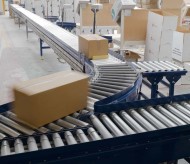 CI Logistics has automated the movement of products for Hodgson Sealants enabling the company to achieve up to a 10% increase in production at their Lymington facility.
CI Logistics has automated the movement of products for Hodgson Sealants enabling the company to achieve up to a 10% increase in production at their Lymington facility.
A continuous conveyor system, which has been designed, manufactured and installed by CI Logistics, transports boxes of butyl sealant products from the first floor of Hodgson Sealants’ Lymington site to the palletising and despatch area on the ground floor.
Hodgson Sealants began life in the late 1960s as a small family firm. Over the last four decades it has grown to become a global supplier of quality sealants. The company operates from two sites, one in the north of England at Beverley and the other based in the south, at Lymington. The Lymington site was purpose built in 1988 and has become the company’s centre for butyl sealant manufacturing and extrusion.
Hodgson Sealant’s engineering manager at Lymington comments, “We approached three different companies to tender for the contract and we were impressed by the detail that CI Logistics put into the design stage. They’d ironed out potential problems all the way through the process right up to installation and commissioning.
“Their automated system was also the best that we looked at; it was ergonomic, modular and more versatile that the other systems which were rigid and fixed in comparison. Because the system is modular, it is relatively maintenance free and will be easy to adapt should we wish to carry out future modifications.”
He continues, “The system was delivered on time and CI Logistics installed it mechanically and electrically in three phased stages. The conveyors are operated by a highly effective control system, which was also designed and developed by CI Logistics.
“It’s an integral part of the automated process, managing the flow of boxes by stalling them if the system is busy at the merge points. Essentially it’s a good system with a minimal number of drive units, which gives a reduced risk of component failure.
“Once the automated system was switched on it had to work from day one as all of the production lines were committed to it. Altogether the installation was relatively seamless and we were pleased with the back up support that CI gave us during that first week.”
The palletised raw butyl sealant arrives by lift onto the upstairs extruder floor, ready prepared for the extrusion process. This raw product is fed to the production lines where each operator can produce between 50 to 120 boxes of extruded product per shift.
All of the extrusion lines are connected by spurs to the main conveyor system. Double lift up gates have been incorporated into a number of these conveyor spur sections to allow access with a pallet truck as necessary. As the operators fill the boxes with finished product, they now simply push them out onto the conveyor system instead of directly placing them onto the pallets.
Transportation of boxes to the ground floor is via one of two conveyor routes; one runs above the main gangway supported by structural steelwork to provide maximum usable floor space, the other emerges from the extruder floor close to the decline section where the two routes merge.
“Our operators are now at their stations extruding product for longer periods, where in the past they had to leave the line to manually pack boxes onto a pallet which was then taken to the ground floor via the lift,” concludes Hodgson Sealant’s engineering manager. “This took time and meant that the production lines’ output had to accommodate those processes. As soon as we became automated we saw the gains in terms of increased production output by up to 10%.”
Hodgson Sealants also believe that installing the conveyor system has helped to protect the health and safety of its staff by reducing a manual handling component of their work.
CI Logistics
Tel: 0116 276 1691




Comments are closed.